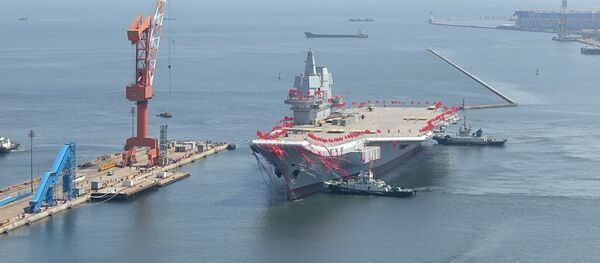Beijing's launch of the Type 001A aircraft carrier from the Dalian shipyard of the China Shipbuilding Industry Corp. has become a national event. Meanwhile, observers wonder whether or not the People's Liberation Army Navy (PLAN) is going to shift the balance of power in the Asia-Pacific region.
"The Chinese fleet is the second to that of the US, in some respects, it is comparable to the Japanese one and surpasses all other fleets [in the region]," Andrei Frolov, Russian military expert and editor-in-chief of Arms Export, told Russian online newspaper Vzglyad.
He believes that the Chinese fleet surpasses even the Russian Pacific Fleet, "maybe with the exception of the submarine component."
"We have more nuclear submarines there, and their technical characteristics exceed those of the Chinese [underwater vessels]. But many nuclear submarines are currently under repair," the expert noted.
Commenting on the historic launch, Russian media outlet Lenta.ru remarked that some observers noticed steel constructions near the dock, which prompted speculations on China preparing to build a third aircraft carrier.
The media outlet noted that although it's hard to compare the US Pacific Fleet and China's Navy in terms of the number of aircraft carriers and warplanes in their air groups, it is obvious that Beijing is determined to boost PLAN's military capabilities of its fleet in the region.
"Previously the Chinese fleet and long-range bomber missile carriers didn't command support from fighter jets at a distance of more than several hundred kilometers off the continental coast," the media outlet underscored, suggesting that the world may soon witness a naval race between Beijing and Washington in the Asia-Pacific region.
According to some observers, one of the main reasons for Washington's plans to boost its fleet is the need to maintain military predominance over China in the region.
"The US Navy is perhaps the greatest source of regional stability in Asia," then Republican nominee Donald Trump's aides Alexander Gray and Peter Navarro wrote for Foreign Policy on November 7, 2016.
"With the Chinese already outnumbering the US Navy in Pacific-based submarines and projected to have 415 warships and nearly 100 submarines by 2030, the mere initiation of the Trump naval program will reassure our allies that the United States remains committed in the long term to its traditional role as guarantor of the liberal order in Asia," Gray and Navarro said.
Still, Russian military expert Vasily Kashin believes that the two geopolitical players will largely maintain the established balance of power in the Asia-Pacific region in the next few years.
"Given the fact that the Chinese aircraft carrier will be completed and enter Navy service only by 2020, the balance of power in the Pacific region won't change in the near future," Russian military expert Vasily Kashin told Vzglyad.
He admitted that in comparison with the US naval fleet Chinese warships have lesser capabilities, but they are intended for another set of tasks:
"They won't be used for missions around the world, they are intended solely for operations in the seas adjacent to China," Kashin stressed.
Indeed, while commenting on the question of whether or not China is planning to establish new naval bases overseas spokesman for China's Ministry of National Defense (MND) Senior Colonel Yang Yujun remarked: "You just mentioned that naval bases should be built all over the world because China has aircraft carriers. I think you think too much."
"The main offshore support facilities for aircraft carriers include the home ports for aircraft carriers, the airfields for aircraft and the training and supporting facilities. They are the main facilities supporting the aircraft carrier troops to carry out daily activities," Yang emphasized.





